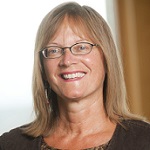 Karla Miller, Northwest Area Foundation
Karla Miller, Northwest Area Foundation
Title: Program Director
On the job since: 2002
Geographic scope: Idaho, Iowa, Minnesota, North Dakota, South Dakota, Oregon, Washington & 75 Native nations
2015 rural funding: $2.5M
Staffing: 23 FTE
How has your career prepared you for your current role?
Prior to joining the Northwest Area Foundation, I was the finance director and microenterprise development director for a community action agency in rural west-central Wisconsin. As an on-the-ground staff person working for an organization addressing poverty, I worked closely with many individuals interested in starting a micro-business (under five employees, usually a self-employment opportunity). Starting you own business is one of the ways to increase family income and build assets. These small businesses are often lacking access to value-added systems for sharing space and operations to build their business ideas.
As the managing director of a community development finance institution (CDFI), I provided access to capital to cooperative businesses. These early mission investors placed their excess cash in the fund which was re-lent to emerging and growing co-op businesses. As manager of this social enterprise, I worked in many rural areas helping to grow and expand cooperative groceries and ag-related businesses by providing access to capital. Both of these experiences built my understanding of rural issues, mission investing and my life-long commitment to rural places.
What are the most important issues for rural grantees in your community?
The Northwest Area Foundation is a regional grantmaker serving eight states and 75 Native Nations. The most important issues for grantees in this region are:
- Equal access to funding opportunities: Reservation communities and Native-led organizations are often not included in the conversation or funding opportunities.
- Increasing voice in policy and advocacy conversations: Local rural and tribal policies are often not included in the policy priorities or advocacy conversations.
- Aging populations in many rural areas: Many rural areas are seeing changing service needs due to an aging population, e.g. transportation, health care, assisted living, affordable housing.
- Increasingly younger population in reservation communities: Many reservation communities are experiencing growing populations under the age of 25. This is creating a need for affordable housing, local jobs and the development of a private economy.
- Lack of access to good jobs: Most rural and reservation communities have not seen a growth spurt in local jobs. Under-investment in community-based economic development in rural and reservation communities means there are not living wage jobs in these communities and the services needed for employment, e.g. quality, affordable childcare, transportation.
- Land access (both lack of access to capital for purchase and rising cost of land): Many rural places have seen increasing costs of land. This prevents the establishment and development of small-scale agriculture operations which are shown to increase family income.
What are your core strategies for addressing these issues?
The foundation focuses its funding in four portfolios that prioritize marginalized communities, including Native Americans, communities of color, people in rural areas, refugees and immigrants. We commit 40% of our annual grantmaking budget to Native-led organizations, many of which are located in reservation communities. Toward the outcomes of good jobs and financial capability, we are funding:
- Work Opportunity in reservation communities to support skills development and to ensure workforce systems includes and works for all people to improve economic outcomes of individuals and families.
- Enterprise Development in rural and reservation communities focused on both the creation and development of micro and social enterprises that provide ownership, jobs and training opportunities.
- Financial Inclusion programs that build financial knowledge and tools providing opportunities to enhance financial security and build prosperity.
- Access to Capital through funding of Native CDFIs (community development finance institutions) that provide equitable access to capital and coaching support.
How are demographics changing in your region, and how is your funding strategy addressing these changes?
In parts of our region, communities of color are among the fastest growing populations. This includes Latinos and African immigrants in rural areas, and a growing youth population in reservation communities. There is also a large population of Hmong American immigrants in rural areas. We provide funding to organizations that are Native-led and led by the populations they serve.
What's been a big success for your organization?
Our commitment of 40% of our annual grantmaking to Native-led organizations. This commitment has provided us better connections and more relationships in reservation communities. Among the positive outcomes for Native Americans:
- First Peoples Fund, a Native-led organization working with artists, has expanded its work throughout the region providing business development services, access to capital, local, tribal and national advocacy for the arts, and increased financial capability of artists.
- Thunder Valley Community Development Corporation, a Native-led organization, is developing a 34-acre site on the Pine Ridge Reservation. A worker-owned construction business is forming to construct affordable housing, their workforce development training is accessed by local businesses, and a multi-organizational effort is coordinating capital access for homeownership.
What’s the biggest rural funding challenge your organization is tackling right now?
Through our commitment to Native-led organizations, we are trying to make the point throughout the funding community that reservation communities are part of rural. Promising outcomes from this focus include aligned funding with other foundations in support of the work of reservation-based organizations and participation in convenings with Native-led organizations and other funders.
What’s one more question we should ask, and how would you answer it?
Q. How can philanthropy increase its investment and impact in rural and reservation communities?
A. Recognizing that many rural and reservation communities are remote and isolated, philanthropy can increase its presence in these communities through local convenings to make new connections and build relationships. Together we can support gatherings of Native leaders to learn more about the challenges and opportunities and listen to the community-driven solutions.
Karla Miller is program director at Northwest Area Foundation, joining us this month for our virtual roundtable with rural funders.